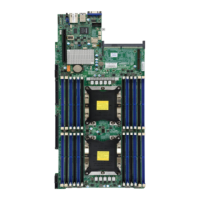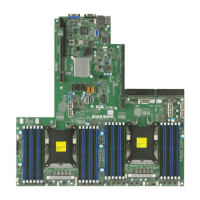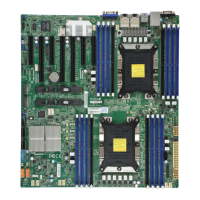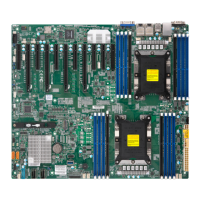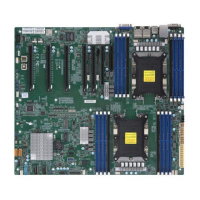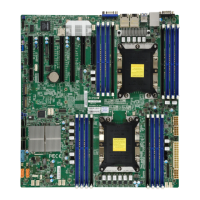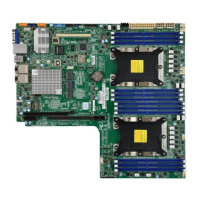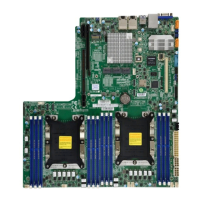Do you have a question about the Supermicro X11DPT-PS and is the answer not in the manual?
Introduction to the manual's purpose and intended audience.
Overview of the X11DPT-PS motherboard features and specifications.
Outlines the structure and content of the manual's chapters and appendices.
Supermicro's main office address, phone, fax, and email information.
Supermicro's European office address, phone, fax, and email details.
Supermicro's Asia-Pacific office address, phone, fax, and email contacts.
Details items included with the motherboard shipment and their purpose.
Provides essential URLs for drivers, utilities, manuals, and support contacts.
Details the supported Intel Xeon processors and their specifications.
Information on memory controller, types, capacity, and speeds supported.
Specifies the maximum DIMM size supported and voltage requirements.
Identifies the Intel C621 chipset used on the motherboard.
Lists the available PCI-Express slots and their configurations.
Describes the ASpeed AST 2500 BMC and its IPMI 2.0 support.
Information about the integrated graphics controller via BMC.
Details Serial, SATA, and RAID I/O functionalities.
Covers USB 3.0 ports on the rear I/O panel.
Details the BIOS type, features like ACPI, PnP, and SMBIOS support.
Explains power management features like AC power recovery and node manager.
Covers voltage monitoring, fan status, and environmental temperature monitoring.
Describes fan control mechanisms via IPMI and BMC.
Details support for TPM, PECI, UID, and system alerts.
Lists the types of LED indicators on the motherboard and their meanings.
Provides the physical dimensions of the motherboard.
Highlights AVX-512 support for enhanced memory bandwidth.
Describes the interconnectivity features for multi-node systems.
Details the variety of I/Os and flexibility in system usage.
Focuses on platform security features like Intel Boot Guard.
Discusses integrated solutions for real-time data processing.
Covers hot-plugging and enclosure management using Intel VMD.
Addresses single server development for NFV transition.
Explains BIOS settings for system response after AC power interruption.
Describes features for monitoring system health, including voltage and temperature.
Details system event notifications using SuperDoctor 5.
Emphasizes the importance of a stable power source for operation.
Describes the Aspeed AST 2500 Super I/O features and functions.
Explains IPNM for real-time thermal and power management.
Describes the Management Engine (ME) for Server Platform Services.
Provides precautions and measures to protect against electrostatic discharge (ESD).
Lists specific steps to prevent ESD damage to components.
Instructions for safely unpacking the motherboard to avoid static damage.
Details the location of mounting holes for chassis compatibility.
Lists the necessary tools for motherboard installation.
Information about the supported Intel processors, including model types.
Identifies components of the CPU socket assembly.
Describes components of the Processor Heatsink Module (PHM).
Step-by-step guide for attaching the CPU to the processor clip.
Instructions for mounting the processor package assembly onto the heatsink.
Details the steps to prepare the CPU socket for installation.
Instructions for safely removing the CPU socket dust cover.
Step-by-step guide for installing the assembled PHM into the CPU socket.
Procedure for safely removing the installed PHM from the motherboard.
Details supported memory types, capacity, and speeds.
Explains the "Fill First" method for populating memory slots.
Outlines general rules for populating memory modules for optimal performance.
Details DIMM configurations for optimal performance.
Provides specific sequences for populating memory slots based on CPU count.
Step-by-step guide for inserting DIMM modules into the slots.
Instructions for safely removing DIMM modules from the motherboard.
Shows the layout and defines the rear I/O ports.
Lists the specific rear I/O ports like USB, VGA, IPMI_LAN.
Details the location and use of the onboard VGA port.
Describes the COM port (COM1) and its pin definitions.
Explains the location and pin definitions of the rear USB 3.0 ports.
Describes the UID switch and LED for system identification.
Details the IPMI dedicated Gigabit LAN port and its RJ45 connection.
Describes the SMCI proprietary connector for power and front panel controls.
Details the onboard fan header (FAN3) for CPU/system cooling.
Describes the JTPM1 header for connecting a Trusted Platform Module (TPM).
Explains the JRK1 header for the RAID key used with NVMe SDD.
Details the SATA ports, their types, and compatibility with SuperDOM.
Explains the basic principle of how jumpers modify motherboard functions.
Procedure for clearing CMOS settings and passwords using the JBT1 jumper.
Instructions for using JPME1 to bypass SPI security for Manufacturing Mode.
Explains the JWD1 Watch Dog function for system reboots on application hangs.
Describes the Link and Activity LEDs for the IPMI LAN port.
Details the BMC Heartbeat LED (BMC_HB_LED) for BMC status.
Explains the HDD LED connection and its function for hard drive activity.
General procedures to troubleshoot system issues before and after power-on.
Steps to check before attempting to power on the system.
Specific steps to diagnose and resolve "No Power" issues.
Steps to diagnose and resolve system boot failures indicated by beeps or no response.
Procedures for identifying and resolving memory-related errors.
Steps to troubleshoot and prevent loss of system setup configuration.
Checks for system instability issues during or after OS installation.
Advises reviewing manual sections and website FAQs before contacting support.
Information on obtaining and applying BIOS upgrades.
Lists essential information required when contacting technical support.
Answers questions about supported memory types and speeds.
Provides guidance on how to update the system BIOS safely.
Explains the behavior of the momentary power button.
Step-by-step guide to safely remove the onboard CMOS battery.
Guidelines for environmentally responsible disposal of used batteries.
Instructions for correctly installing a new onboard CMOS battery.
Overview of the AMIBIOS Setup utility and its features.
Instructions on how to enter the BIOS setup utility.
How to set the system date and time within the BIOS.
Displays the version of the BIOS ROM used in the system.
Shows the date when the BIOS ROM version was built.
Displays the version of the Complex-Programmable Logical Device (CPLD).
Provides details on the total system memory and its speed.
Configuration options related to the system's boot process.
Controls whether the system waits for F1 key press upon error.
Manages how the system handles Interrupt 19 for boot disk functions.
Configures automatic system reboot after initial boot failure.
Enables Windows 7 and XHCI drivers for USB keyboard/mouse support.
Enables I/O Port 61h-Bit 4 emulation for enhanced system performance.
Settings related to system power management and recovery.
Configuration options related to the system's CPU.
Enables Intel Virtualization Technology for I/O device assignments.
Controls the Protected-Processor Inventory Number (PPIN) in the system.
Enables hardware prefetcher to improve CPU performance.
Configures prefetching of cache lines for improved CPU performance.
Enables DCU Streamer Prefetcher to speed up data accessing.
Enables IP prefetcher in DCU to improve network connectivity.
Enables LLC (hardware cache) prefetching on all threads.
Expands APIC IDs for enhanced CPU performance and thread management.
Enables Intel AES-NI for enhanced data security.
Configuration options for advanced system power management.
Controls CPU P-state settings for voltage and frequency adjustment.
Manages hardware P-state settings based on OS requests or native mode.
Controls CPU C-State settings for power saving.
Configuration options for the system's chipset.
Allows configuration of settings for the Intel North Bridge.
Configures settings for Intel Ultra Path Interconnect.
Configuration options for system memory modules.
Configures memory RAS settings for reliability and availability.
Configuration options for the Integrated I/O Hub (IIO).
Configures PCI-E Bifurcation settings for CPU1 and CPU2.
Configuration options for IOAT (I/O Acceleration Technology).
Enables Intel VT for Directed I/O (VT-d) for I/O resource sharing.
Displays South Bridge information and configuration options.
Configuration settings for the system's Management Engine (ME).
Configuration options for the PCH SATA controller.
Configuration options for the PCH sSATA controller.
Configuration options for PCIe, PCI, and PnP devices.
Configuration options for network stack support and boot methods.
Configuration options for the Super IO chip.
Configuration for the first onboard serial port.
Configuration for the second onboard serial port.
Configuration for serial port console redirection.
Configuration for Serial-Over-LAN (SOL) port console redirection.
Settings for legacy console redirection and OPROM messages.
Enables COM port for EMS console redirection.
Configures Advanced Configuration and Power Interface (ACPI) settings.
Information and settings for a detected TPM device.
Schedules TPM-related operations for system data integrity.
Enables TPM Platform Hierarchy support for security algorithms.
Enables Intel Trusted Execution Technology (TXT) for system security.
Configuration options for iSCSI Initiator.
Configuration for Intel Virtual RAID on CPU (VROC).
Options for enabling/disabling and erasing SMBIOS event logs.
Standard settings for SMBIOS event logging, including boot events and counters.
Options for logging OEM codes and converting EFI status codes.
Allows viewing of system event log entries with date, time, and severity.
Options for enabling/disabling and erasing the System Event Log (SEL).
Configuration settings for the BMC's network interface.
Enables or disables IPv6 support for network configuration.
Selects the source for IP address configuration (DHCP or Static).
Sets the administrator password for BIOS setup utility access.
Sets the user password for BIOS setup utility access.
Configures when the system checks for passwords (Setup or Always).
Activates Secure Boot when a Platform Key (PK) is entered.
Selects the desired secure boot mode (Standard or Custom).
Enables CMS support for enhanced system performance.
Manages security keys, including provisioning defaults and enrollment.
Configures authorized signatures for system security.
Configures forbidden signatures for system security.
Selects the type of devices for system boot (Legacy, UEFI, Dual).
Enables booting from EFI OS when Legacy OS fails.
Prioritizes the order of bootable devices for system startup.
Allows adding new boot options to the boot priority list.
Selects and deletes boot devices from the priority list.
Adds new driver options to the boot priority list.
Selects and deletes boot drivers from the priority list.
Options for saving or discarding changes made in BIOS setup.
Options for restoring default BIOS settings or saving user configurations.
Instructions for downloading and installing software from the Supermicro website.
Details the SuperDoctor 5 hardware monitoring program and its features.
Specific warnings and instructions regarding battery handling and replacement.
Provides an overview of the Unified Extensible Firmware Interface (UEFI).
Steps for recovering the UEFI BIOS image from its recovery block.
Procedure for recovering the main BIOS block using a USB device.
| CPU | Dual Intel Xeon Scalable Processors |
|---|---|
| CPU Socket | LGA 3647 |
| Chipset | Intel C621 |
| Memory Type | DDR4 |
| Max Memory | 2TB |
| Supported Memory Types | ECC RDIMM, ECC LRDIMM |
| Expansion Slots | 7 |
| M.2 Slots | 2 |
| SATA Ports | 8 |
| USB Ports | 4 x USB 3.0, 2 x USB 2.0 |
| Network | Dual 10G Ethernet |
| Power Connectors | 2x 24-pin ATX power connectors, 2x 8-pin EPS 12V power connectors |
| Memory Slots | 16 DIMM slots |
